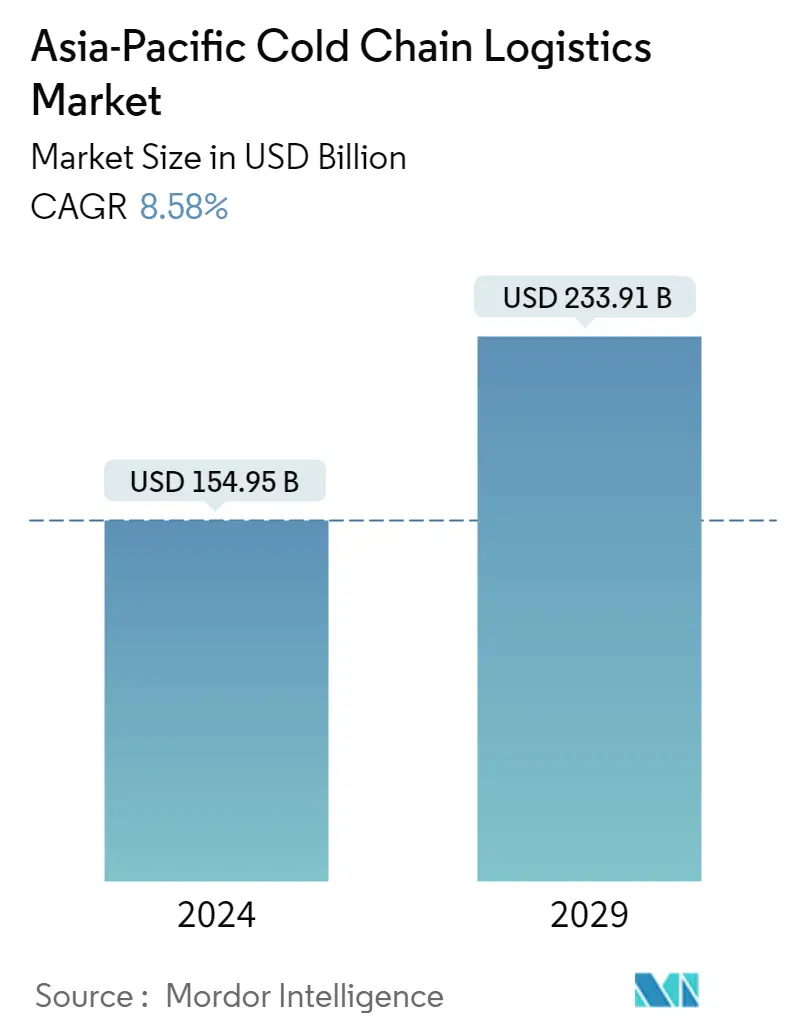Market Size of Asia-Pacific Cold Chain Logistics Industry

| Study Period | 2019 - 2029 |
| Base Year For Estimation | 2023 |
| Market Size (2024) | USD 154.95 Billion |
| Market Size (2029) | USD 233.91 Billion |
| CAGR (2024 - 2029) | 8.58 % |
| Market Concentration | Low |
Major Players
*Disclaimer: Major Players sorted in no particular order |
Asia Pacific Cold Chain Logistics Market Analysis
The Asia-Pacific Cold Chain Logistics Market size is estimated at USD 154.95 billion in 2024, and is expected to reach USD 233.91 billion by 2029, growing at a CAGR of 8.58% during the forecast period (2024-2029).
Factors such as the increasing number of refrigerated warehouses and the development of the pharmaceutical sector are expected to drive the growth of the Asia-Pacific cold chain logistics market.
- Cold chain logistics are popular in the Asia Pacific. The region has a large consumer base, accounting for roughly 60% of the global population. Demand for premium products is increasing, driven by rising disposable incomes and a shift in dietary habits. Transportation for these products is also important. Of course, COVID-19 has had an impact on Asian cold chain operations, including increased concerns about food safety. This is already changing consumer habits, with more people buying fresh and frozen food from organized retail channels like supermarkets rather than traditional wet markets. The rise of e-commerce and online food retailing has also fueled demand for frozen foods. These trends have increased the demand for cold storage facilities in the region and bolstered further investments in infrastructure and transportation improvements.
- Japan is regarded as a mature market for cold chain logistics, with several players dominating. Nichirei Logistics Group Inc., based in Tokyo, was founded in 1945 as Nippon Reizo Inc. Today, the company provides warehousing, cold storage, and transportation services in Japan and around the world. Customers in a variety of industries use its low-temperature logistics services, including restaurants, retail stores, food manufacturers, trading companies, and wholesalers. The 'upper limit on overtime hours in automobile driving operations' will be implemented in Japan in 2024, raising concerns about the impact on the transportation and logistics industries. Technological innovation is also expected to improve work efficiency, reduce workplace errors, and prevent accidents.
- The availability of Radio-frequency identification (RFID) technologies for cold chain applications and the adoption of automated software for cold chain logistics is projected to offer lucrative growth opportunities for the market players. Recent years have seen robust demand for high-quality industrial and logistics assets in Asia-Pacific due to strong domestic consumption, the e-commerce industry's expansion, and the development of modern logistics facilities. Due to the rising disposable income and ageing population, Asia-Pacific has a vast consumer base for healthcare supplies. There are increasing concerns over food safety and a continuous shift in consumer habits to buy fresh and frozen food products from organized retail channels, such as supermarkets, compared to traditional wet markets.
- The shift in dietary patterns is increasing the demand for premium products, including meat, dairy, and seafood, which are temperature-sensitive and need to be stored and transported at controlled temperatures. Despite robust leasing demand for cold storage facilities in Asia-Pacific, cold storage capacity in the region is limited compared to that in developed western markets. Cold storage facilities command higher rental premiums than dry warehouses. However, factors such as lack of standardization about operating procedures, security, temperature, pest control, and increased operational costs restrain the market's growth.
Asia Pacific Cold Chain Logistics Industry Segmentation
Cold chain logistics transport temperature-controlled products, such as temperature-sensitive foods, equipment, and biopharmaceutical products. The report covers the complete background analysis of the Asia-Pacific Cold Chain Logistics Market, including the assessment of the economy and contribution of sectors in the economy, market overview, market size estimation for key segments, emerging trends in the market segments, market dynamics, and geographical trends, and COVID-19 impact.
The Asia-Pacific Cold Chain Logistics Market is segmented By Services (Storage, Transportation, and Value-added Services (Blast Freezing, Labeling, Inventory Management, Etc.)), By Temperature Type (Chilled, and Frozen), By Application (Horticulture (Fresh Fruits and Vegetables), Dairy Products (Milk, Ice-cream, Butter, Etc.), Meats, Fish & Poultry, Processed Food Products, Pharma, Life Sciences, & Chemicals, and Other Applications), and By Country (China, Japan, India, South Korea, Indonesia, Thailand, Australia, Philippines, and Rest of Asia-Pacific). The report offers the market size and forecasts in terms of value (USD billion) for all the above segments.
| By Services | |
| Storage | |
| Transportation | |
| Value-added Services (Blast Freezing, Labeling, Inventory Management, Etc.) |
| By Temperature Type | |
| Chilled | |
| Frozen |
| By Application | |
| Horticulture (Fresh Fruits and Vegetables) | |
| Dairy Products (Milk, Ice-cream, Butter, Etc.) | |
| Meats, Fish, Poultry | |
| Processed Food Products | |
| Pharma, Life Sciences, and Chemicals | |
| Other Applications |
| By Country | |
| China | |
| Japan | |
| India | |
| South Korea | |
| Indonesia | |
| Thailand | |
| Australia | |
| Philippines | |
| Rest of Asia-Pacific |
Asia-Pacific Cold Chain Logistics Market Size Summary
The Asia-Pacific cold chain logistics market is poised for significant growth, driven by factors such as the increasing number of refrigerated warehouses and advancements in the pharmaceutical sector. The region's vast consumer base, which constitutes a substantial portion of the global population, is experiencing a rise in demand for premium products due to higher disposable incomes and changing dietary habits. This shift has led to a greater reliance on organized retail channels for fresh and frozen foods, further fueled by the expansion of e-commerce and online food retailing. The COVID-19 pandemic has also heightened concerns about food safety, prompting changes in consumer purchasing behavior and increasing the need for robust cold storage facilities. Despite the strong demand for cold storage, the region faces challenges such as limited capacity compared to developed western markets and higher rental premiums for cold storage facilities.
Japan stands out as a mature market within the region, with established players like Nichirei Logistics Group Inc. dominating the landscape. The country's logistics industry is undergoing rapid automation developments to address labor shortages and aging workforce issues. While trucking and coastal shipping are the primary modes of transport, the efficient railway network is underutilized for logistics despite its effectiveness for passenger transport. The market is characterized by a high degree of fragmentation, with both global and local players like UPS, OOCL Logistics, and JWD InfoLogistics actively participating. However, the industry faces challenges such as energy consumption, space limitations, and the need for standardization in storage temperature and operating procedures. Despite these challenges, the market is expected to benefit from technological innovations like RFID and automated software, which offer promising growth opportunities.
Asia-Pacific Cold Chain Logistics Market Size - Table of Contents
-
1. MARKET INSIGHTS DYNAMICS
-
1.1 Current Market Scenario
-
1.2 Market Overview
-
1.3 Market Dynamics
-
1.3.1 Drivers
-
1.3.2 Restraints
-
1.3.3 Opportunities
-
-
1.4 Value Chain / Supply Chain Analysis
-
1.5 Porters Five Forces Analysis
-
1.5.1 Threat of New Entrants
-
1.5.2 Bargaining Power of Buyers/Consumers
-
1.5.3 Bargaining Power of Suppliers
-
1.5.4 Threat of Substitute Products
-
1.5.5 Intensity of Competitive Rivalry
-
-
1.6 Technological Trends and Automation
-
1.7 Government Regulations and Initiatives
-
1.8 Spotlight on Ambient/Temperature-controlled Storage
-
1.9 Impact of Emission Standards and Regulations on Cold Chain Industry
-
1.10 Impact of COVID-19 on the Market
-
-
2. MARKET SEGMENTATION
-
2.1 By Services
-
2.1.1 Storage
-
2.1.2 Transportation
-
2.1.3 Value-added Services (Blast Freezing, Labeling, Inventory Management, Etc.)
-
-
2.2 By Temperature Type
-
2.2.1 Chilled
-
2.2.2 Frozen
-
-
2.3 By Application
-
2.3.1 Horticulture (Fresh Fruits and Vegetables)
-
2.3.2 Dairy Products (Milk, Ice-cream, Butter, Etc.)
-
2.3.3 Meats, Fish, Poultry
-
2.3.4 Processed Food Products
-
2.3.5 Pharma, Life Sciences, and Chemicals
-
2.3.6 Other Applications
-
-
2.4 By Country
-
2.4.1 China
-
2.4.2 Japan
-
2.4.3 India
-
2.4.4 South Korea
-
2.4.5 Indonesia
-
2.4.6 Thailand
-
2.4.7 Australia
-
2.4.8 Philippines
-
2.4.9 Rest of Asia-Pacific
-
-
Asia-Pacific Cold Chain Logistics Market Size FAQs
How big is the Asia-Pacific Cold Chain Logistics Market?
The Asia-Pacific Cold Chain Logistics Market size is expected to reach USD 154.95 billion in 2024 and grow at a CAGR of 8.58% to reach USD 233.91 billion by 2029.
What is the current Asia-Pacific Cold Chain Logistics Market size?
In 2024, the Asia-Pacific Cold Chain Logistics Market size is expected to reach USD 154.95 billion.

